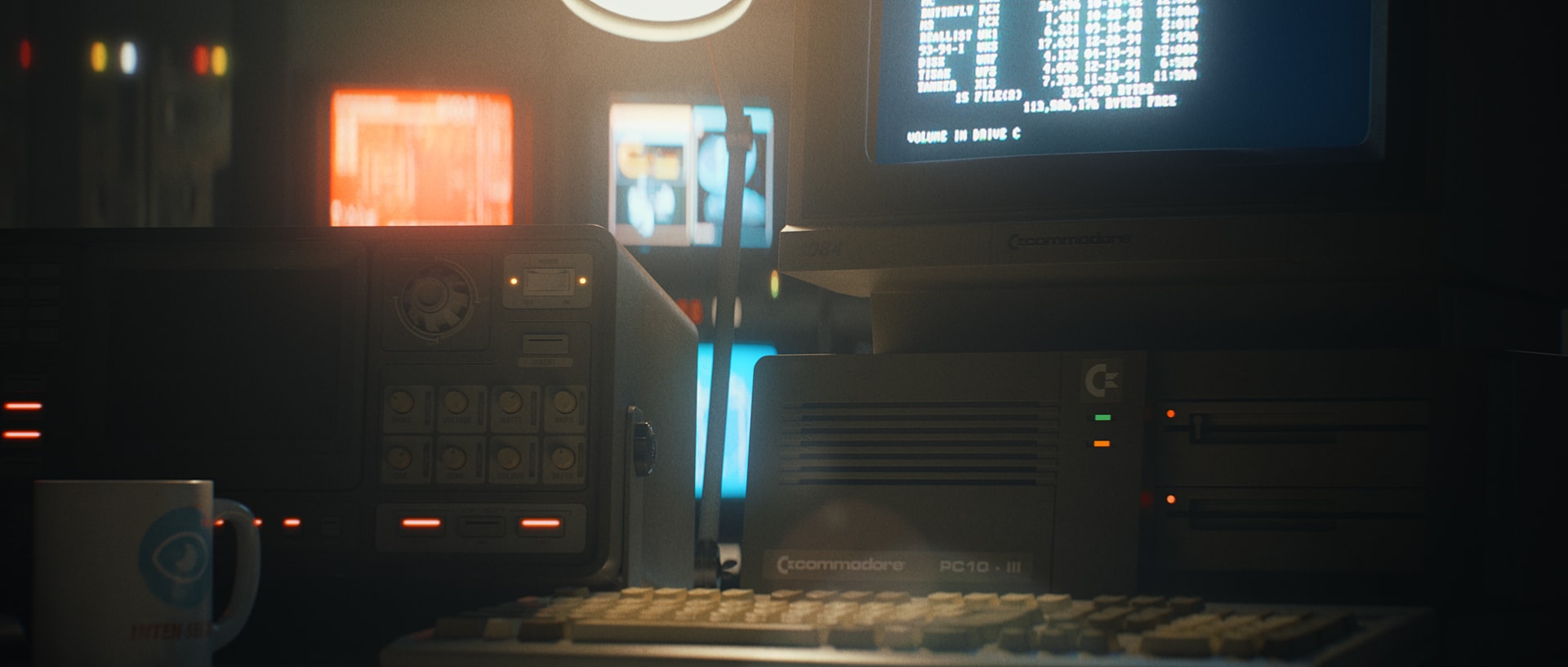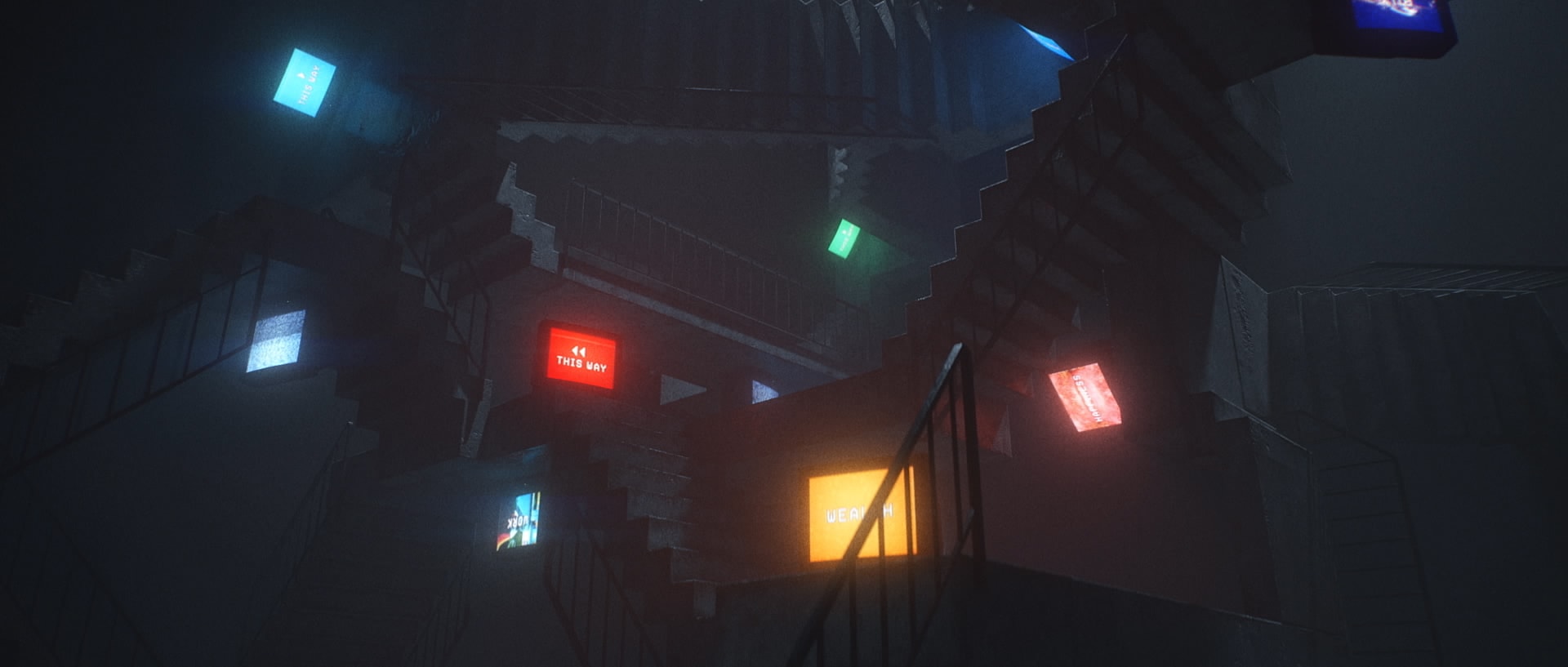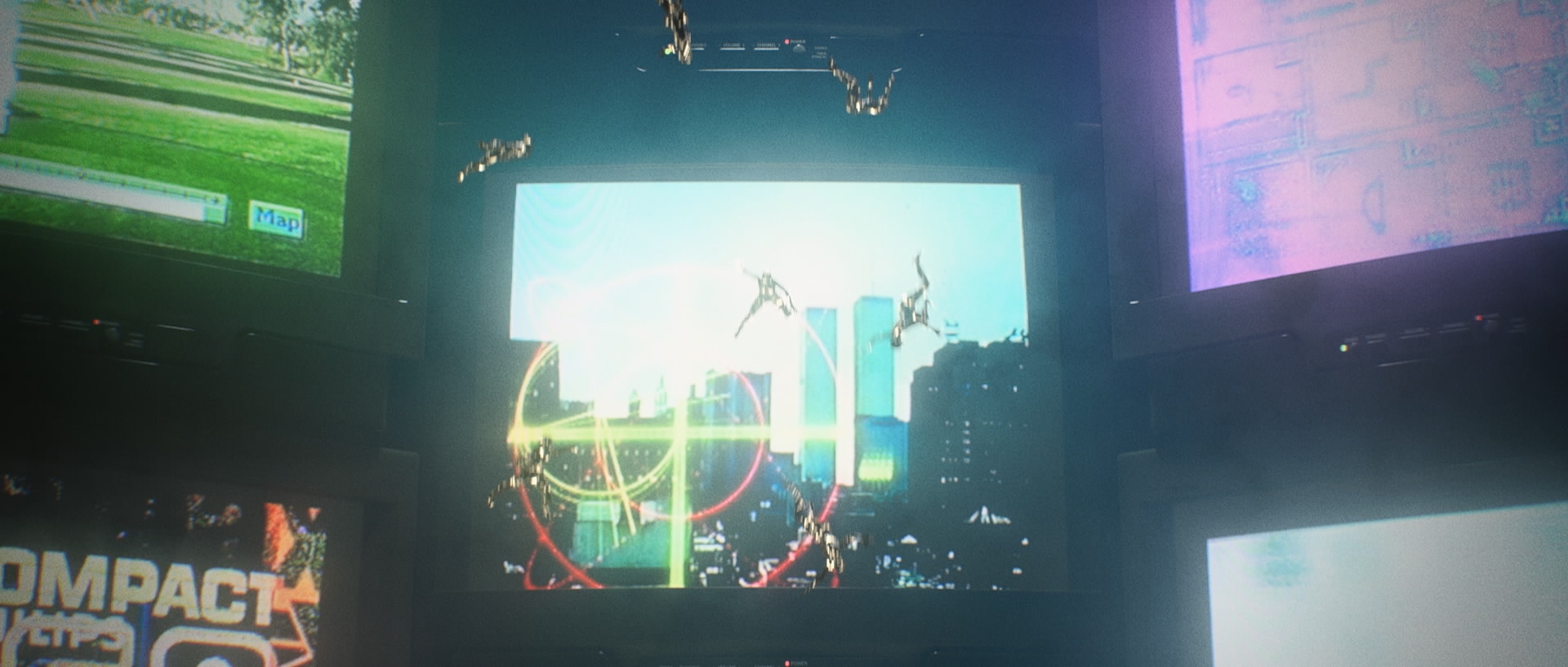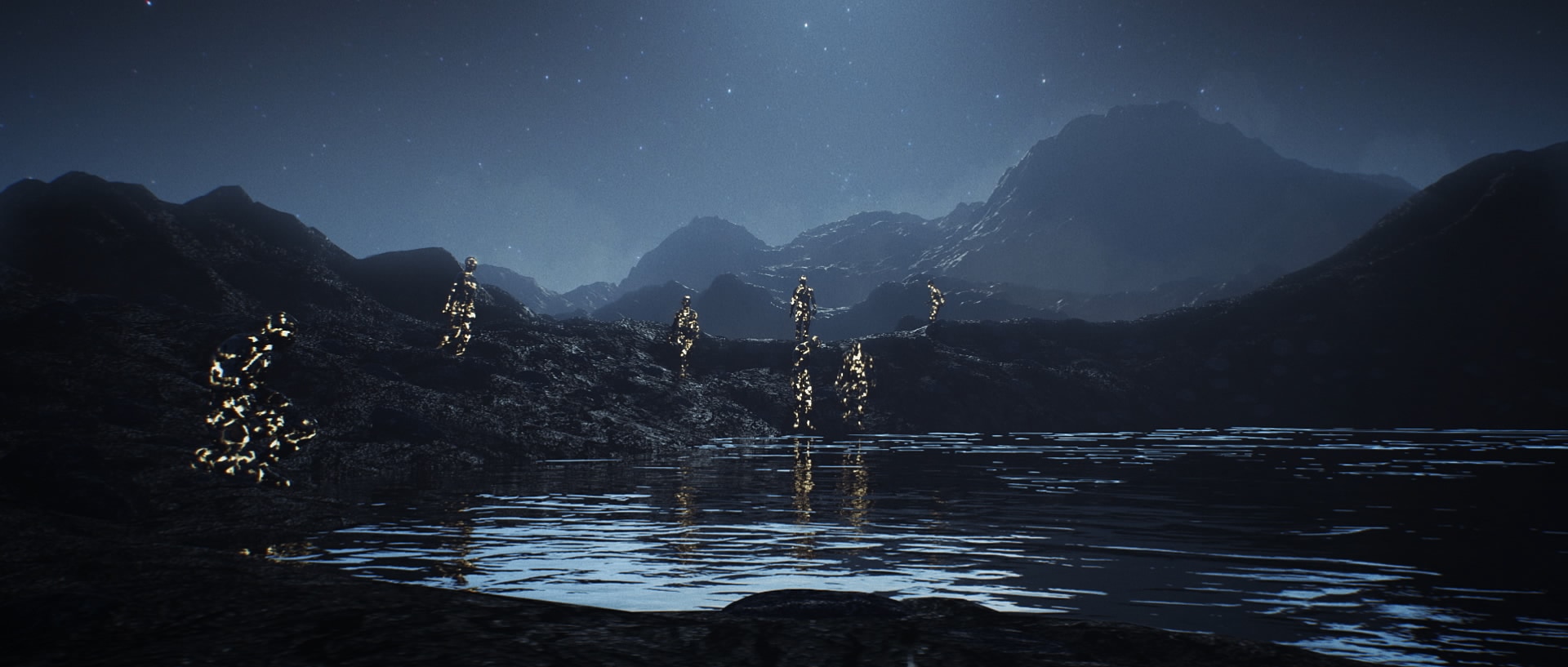With the advent of GPU rendering technology, we begin to see small groups and individuals create more ambitious 3D shorts that a few years ago would take large teams and significantly more time to produce. Raoul Marks with his opening for Semi-Permanent 2015 was one of the first to really show what a single motion designer can do with GPU tech. Doors are constantly opening and each day talented artists are finding new ways to express their vision with less friction from the tools themselves. Another such artist that’s pushing these boundaries is Thom Haig.
I first became aware of Thom’s work while posting in the Redshift user forums. His new film, ‘Other Side’ is a beautiful waltz of both narrative prowess and technical proficiency. Its engrossing narration asks relevant questions of social disparity, social distrust and the idea of working towards something more than social and financial ascension.
Today we’ll be chatting with Thom about his journey in creating the short.
Q&A with Thom Haig
Hi Thom, it’s a pleasure to have this conversation with you. For those who may not know you, give us a short intro about yourself.
Hi! Thanks for having me. I’m a London-based motion graphic designer, director, and film-maker. Although I studied graphic design briefly, I actually quit in favour of audio arts but my experience in design and video led to my first job as a designer, and I haven’t looked back. I love working in 3D and, while I enjoy improving my knowledge and technical skill set, what I find most exciting as I improve is the infinite possibilities that the medium offers me as a director and storyteller.
I previously worked full-time for a handful of London studios and enjoyed making small shots for my showreel but never entire films. Eventually, though, I found myself frustrated by studio work and the inevitability of clients forcing poor design choices on projects. I wanted to be able to dedicate more time to making personal work and this was the driving factor in my decision to go freelance.
Now, I work mostly remotely and balance freelance design work with my own personal projects. Other Side is the third in an unintentional triptych of short films in which I’ve tried to explore some of the issues that have interested me at the time.

Being a big proponent of personal projects myself, I know it takes a tremendous amount of effort and motivation to create such a piece. What motivates you to create these pieces and what do you think keeps you motivated to see it through to the end?
As I said, personal projects are often the most motivating part of my work as a designer. They’re an excellent way to learn new things (software and techniques) and they provide a platform for me to demonstrate my own abilities and progress.
I also find that personal projects are an excellent platform for expression. For me, making one-off shots for Instagram feels too transient; I want to make something lasting, something that can be appreciated beyond just the design community through an engaging idea and script. Sometimes I actively look for inspiration or subject matter, but often it happens quite naturally and an idea will come together from things I’ve read or seen. For example, Other Side was at least partly inspired by The Spirit Level, which is a book published in 2009 but still immensely relevant about ‘why more equal societies almost always do better’. (If you haven’t read it, you should. It’s great.)
That said, while personal projects are a passion of mine, bigger projects can become a bit of a ball-and-chain towards the end. At that point, I think my main motivation is usually getting the project out so I can move on to the next one, and take some time to reflect on what I’ve learned.

With all that’s going on in the world, this topic is quite relevant, why’d you choose this theme?
I know what you mean! Unfortunately, it feels like the topics I explored in Other Side have only become more relevant since its initial conception.
I foresaw that the EU referendum would be marginal. I voted to remain, so I was disappointed by the result. But in the aftermath, I found that what actually disappointed me more than the results themselves was the media’s narrative of ‘Broken Britain’ and a ‘divided society’. The press made it sound like we were plummeting into a civil-war fuelled by hatred and difference. While I can’t speak for every voter, I know good people who voted differently to me. While I don’t agree with how they voted, I know they’re decent people with sound motivations. I found myself annoyed by the simplistic stereotyping of voters which, to me, only served to widen gaps in our communities and society.
Around the same time, in America, Trump got elected. Again, bad news for me (for all of us); he’s an appalling excuse for a president. But it did mean that the script for Other Side would likely speak to an even broader audience, and I found this served as further motivation.
The film became a way for me to explore tolerance and understanding as solutions to the divisions we face in 2016-17; how we might be able to bridge societal divides and learn about different attitudes through an understanding of our commonality. It’s a big idea but it felt right – and timely – to try to say it.

Looking at this piece, many people likely wouldn’t have clue as to where to start with something like this. What’s your process like? Do you start with thumbnails and reference?
Once I have the initial idea in place, I typically work in tandem between the script and visuals, but the script is always the leader in this relationship. There have been times where I’ve really wanted to include a specific visual idea but if the script is worse for it, then it usually feels too forced. That said, I almost always have an idea of the visuals I’d like in the back of my mind during the writing process.
Next, it’s a case of amassing as much imagery and reference material as possible. Obviously, there are tons to explore online. Certain resources, such as Pinterest can be a danger, however, since there are so many people referencing the same small handful of images. I’m a big believer in looking outside of the motion graphics community for inspiration. Other Side was a great excuse for a trip to the London Science Museum to photograph some very beautiful, very cool, old computer-hardware.
From there, it’s what I believe is a quite a typical process: I’ll record a guide voice-over and place this reference imagery on a timeline and see how it all feels. Once all these aspects are in place, I’ll start making the shots.
Ah, it is really helpful to get out of your go to spots when it comes to finding inspiration. Good stuff. We’ll give the audience a view of your process reel so they can get a peek into your process.
I heard that you were convinced to use Redshift for this project. What was your experience using this renderer? Did you see any advantages using Redshift?
I had barely used Redshift when the project began so I did some R&D to address if it was worth using. It was. In fact, using Redshift quickly became a necessity for this project due to the large quantity of low-lit interior scenes I wanted to include. I found that Octane struggled to get a clean render in a reasonable time but Redshift tore through it.
Redshift was also very stable and reliable. Despite the Cinema 4d plugin being in alpha throughout the production, I had minimal crashes and found Redshift really easy to work with and reliable with all the multi-pass options I could ask for.
I’m not fanatical about any renderers as a rule, but my experience with Redshift on this project was positive and I’d recommend giving it a go.

What are some of the tools you used for this project?
A personal favourite, and one of the more unique tools I used on Other Side, was an old 4×3 CRT Television. All the screen content was burnt to DVD, played back on that TV and captured in 4K to get a genuine ‘old TV’ look. CRT screens have a unique look because their pixel arrangement is split into 3 vertical strips (for R, G & B). Like so many of us, I spent my childhood looking at these screens. Maybe the reason I like them is that they evoke some kind of nostalgia and, from a practical angle, I don’t think you could easily replicate this look with software.
In addition to this, a very talented simulation artist (Ben Watts) used Houdini and I also used 3D-Coat & Substance Painter for asset generation.

Having worked on my own personal project for the last 7 months (and still ongoing), I know how difficult it can be to find time to work on personal stuff between client work. How do you balance your work schedule when creating a piece such as this?
I switch between projects and client work. If I find client work frustrating I try to turn that into positive energy and motivation towards my personal project. I’m as guilty as anyone else for squeezing time into late evenings on it. When I’m working on client stuff during the day, an evening with my personal projects feels like a hobby. At some points during Other Side, I felt like an old guy building a ship out of matchsticks, in his garden shed, late into the night.
Setting both interim and final deadlines is important. It’s easy to fall into this perpetual ‘I’m working on a personal project’ lifestyle. I think with experience it’s easy to get an idea of what you can achieve in a time limit. I’m ambitious with my deadlines but, if they start to look unreasonable, I won’t beat myself up about it, I’ll just use that as motivation to hit the next one.
I didn’t know it at the time, but having a real deadline introduced was actually the-shot-in-the arm this project needed. This was the first time I’ve collaborated with other artists/designers on a personal piece. I’d delegated some roles without a firm deadline, and it was hard for everyone to allocate time to the project. When I was invited to IBC to talk for Maxon, I knew I wanted it to be about Other Side, so we all hauled-ass and managed to get it done in time. There’s nothing like a bit of pressure to speed things up.

What advice would you give to artists trying to make their own personal projects?
Be ambitious, but reasonable, in that order. Other Side was originally going to be about another minute longer. I had trouble coming to terms with how much I had to do, and some of the shots were wildly over-ambitious. I wasted a lot of time trying to make one scene that never made it into the film. Making the decision to strip-back the script not only made me feel like finishing the project was much more achievable, but also made for a more concise and engaging film.
Unless you’re only interested in displaying technical proficiency, making something that has the potential to be engaging outside of design-circles will make for better, more relatable work.
Draw inspiration from things outside of art and design which might only inspire you to replicate existing artworks. It’s too shallow a pool to take real inspiration from. Watch documentaries, read books and articles, play video games and engage with the media. And if you still find you’re stuck on an idea: collaborate! Work with writers and poets. These are people who would really appreciate having quality motion design work to their name.
Have a small council of other designers/non-designers who you can share your work-in-progress with. People whose opinion’s you value and who won’t be afraid of telling you where they think your work falls-short. And listen to what they say.

Thom, I want to thank you for sharing your process with the community. I think your insight will be both invaluable and inspirational to those who are working on their own personal projects. Looking forward to what you will produce next!
Thank you! And thanks for inviting me to talk about my work.






